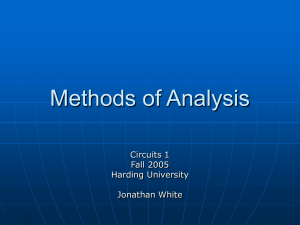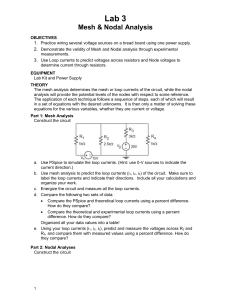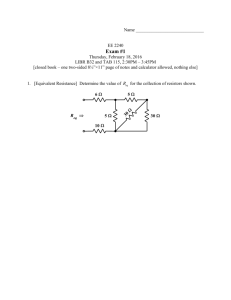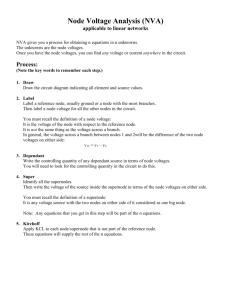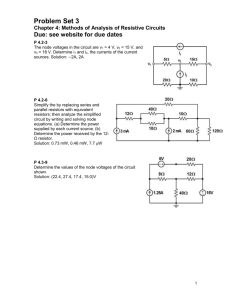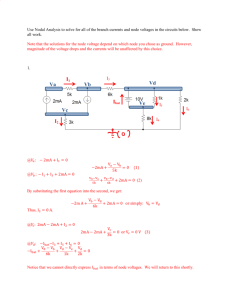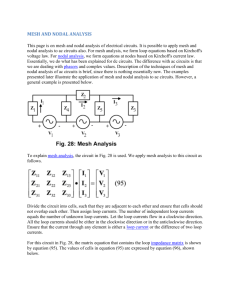EEE201_Exp_5_Node_Mesh_Analysis
advertisement
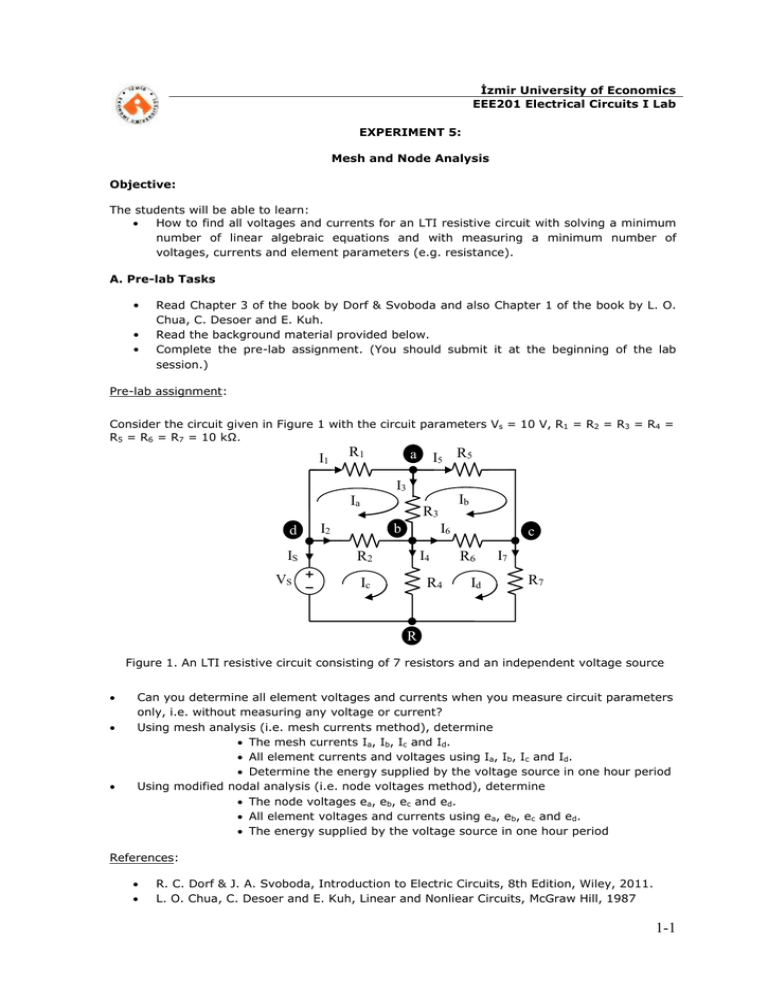
İzmir University of Economics EEE201 Electrical Circuits I Lab EXPERIMENT 5: Mesh and Node Analysis Objective: The students will be able to learn: How to find all voltages and currents for an LTI resistive circuit with solving a minimum number of linear algebraic equations and with measuring a minimum number of voltages, currents and element parameters (e.g. resistance). A. Pre-lab Tasks • • • Read Chapter 3 of the book by Dorf & Svoboda and also Chapter 1 of the book by L. O. Chua, C. Desoer and E. Kuh. Read the background material provided below. Complete the pre-lab assignment. (You should submit it at the beginning of the lab session.) Pre-lab assignment: Consider the circuit given in Figure 1 with the circuit parameters Vs = 10 V, R1 = R2 = R3 = R4 = R5 = R6 = R7 = 10 kΩ. I1 R1 I5 R5 a I3 Ia d IS VS Ib R3 I2 b I6 I4 R2 Ic R4 c R6 Id I7 R7 R Figure 1. An LTI resistive circuit consisting of 7 resistors and an independent voltage source Can you determine all element voltages and currents when you measure circuit parameters only, i.e. without measuring any voltage or current? Using mesh analysis (i.e. mesh currents method), determine The mesh currents Ia, Ib, Ic and Id. All element currents and voltages using Ia, Ib, Ic and Id. Determine the energy supplied by the voltage source in one hour period Using modified nodal analysis (i.e. node voltages method), determine The node voltages ea, eb, ec and ed. All element voltages and currents using ea, eb, ec and ed. The energy supplied by the voltage source in one hour period References: R. C. Dorf & J. A. Svoboda, Introduction to Electric Circuits, 8th Edition, Wiley, 2011. L. O. Chua, C. Desoer and E. Kuh, Linear and Nonliear Circuits, McGraw Hill, 1987 1-1 B. Background Circuit equations of a circuit are KVL and KVL equations, which are dependent on the circuit topology only, and the constitutive relations defining circuit elements. A list of circuit equations is called as tableau equations which are in terms of all voltages and currents related to a chosen statement of KVL and KCL equations such as KCL equations for nodes and KVL equations representing element voltages in terms of node voltages. Any circuit analysis method is based on eliminating a part of the voltage and current variables in a systematic way, indeed just by substitution, and then reaching a relatively small set of circuit equations in terms of the remaining variables. A circuit analysis method is called as mesh analysis if the variables remained in the circuit equations obtained by elimination are the mesh currents. A circuit analysis method is called as nodal analysis if the remaining variables are the node voltages. Based on a chosen tree in a circuit graph, link currents method and branch voltages method are used for analyzing LTI resistive circuits in a similar way of mesh currents method and node voltages method, respectively. The mesh analysis and nodal analysis which are the most widely used circuit analysis methods are explained below. B.1. Mesh Analysis (Mesh Currents Method): The first step of the mesh analysis is to identify meshes and then assign mesh currents which are assumed to flow through the meshes as shown for the circuit in Figure 2. R1 I1 Ia I2 I3 R2 VS Ib I4 R4 R3 Ic I5 R5 Figure 2. An LTI resistive circuit having three meshes The second step of the mesh analysis is to write KVL equations for meshes. As an example, the KVL equations for the three meshes of the circuit of Figure 2 can be written as: Mesh a: V1 - V3 - V2 = 0 Mesh b: - VS + V2 - V5 = 0 Mesh c: V3 + V5 - V4 = 0 In the third step of the mesh analysis, the element voltages for the resistors are eliminated by substituting their expressions in terms of the element currents as implied by ohm’s law. For the circuit in Figure 2, the KVL equations written above become as follows. Mesh a: R1 I1 - R3 I3 – R2 I2 = 0 Mesh b: – Vs + R2 I2 + R4 I4 = 0 Mesh c: R3 I3 + R5 I5 – R4 I4 = 0 In the fourth step of the mesh analysis, the element currents introduced in the third step are 1-2 eliminated by writing them in terms of the mesh currents. In the example under consideration, the element currents I1, I2, I3, I4 and I5 are expressed in terms of the unknown mesh currents Ia, Ib and Ic as: I1 = Ia I2 = Ib - Ia I3 = Ic – Ia I4 = Ib - Ic I5 = Ic Substituting the above expressions into the mesh equations obtained in the third step and bringing the known voltages on the right hand side, the following mesh currents equations in germs of the mesh currents Ia, Ib, and Ic are obtained. Mesh a: R1 Ia - R3 (Ic –Ia)– R2 (Ib – Ia) = 0 Mesh b: R2 (Ib – Ia) + R4 (Ib – Ic) = VS Mesh c: R3 (Ic –Ia) + R5 Ic – R4 (Ib – Ic) = 0 The mesh currents equations obtained above can also be written in the following scalar and matrix forms which can also be written by inspection from the circuit. Mesh a: R1 Ia + R3 (Ia –Ic) + R2 (Ia – Ib) = 0 Mesh b: R2 (Ib – Ia) + R4 (Ib – Ic) = VS Mesh c: R3 (Ic –Ia) + R5 Ic + R4 (Ic – Ib) = 0 Mesh a: (R1 + R2 + R3) Ia - R2 Ib – R3 Ic = 0 Mesh b: - R2 Ia + (R2 + R4) Ib – R4 Ic = VS Mesh c: - R3 Ia – R4 Ib + (R3 + R4 + R5) Ic = 0 [ R1 + R 2 + R 3 −R 2 −R 3 −R 2 R2 + R4 −R 4 −R 3 Ia 0 −R 4 ] [Ib ] = [𝑉𝑆 ] R 3 + R 4 + R 5 Ic 0 Note: i th diagonal entry is the sum of resistances of the resistors belonging to the i th mesh. The i th row j th column (off diagonal) entry is the opposite in sign of the sum of resistances belonging to the i th and j th meshes. Solving the set of linear algebraic equations, the mesh currents Ia, Ib and Ic are determined. Then, first the element currents can be obtained by using their expressions in terms of mesh currents and second the element voltages by using ohm’s law for the LTI resistors. Modified Mesh Analysis: The mesh analysis, which is valid for LTI resistive circuits made of 2terminal resistors and independent voltage sources, can be generalized into any kind of LTI resistive circuit containing elements which are not current controlled. The generalized mesh analysis, which is also called as modified mesh currents analysis, is based on i) eliminating all voltages and currents of the current controlled elements, called as the first type of elements for mesh analysis, to reach mesh equations in terms of the mesh currents and ii) writing the constitutive relations of the non-current controlled elements, called as the second type of elements for the mesh analysis, in terms of the mesh currents and the voltages of the second type elements. 1-3 B.2. Nodal Analysis (Node Voltage Method): The nodal analysis is valid only for LTI resistive circuits made of 2-terminal resistors and independent current sources which are voltage controlled elements enabling to write their currents in terms of their voltages and so node voltages. The nodal analysis is based on eliminating all voltages and currents by substituting their expressions in terms of the node voltages. The nodal analysis provides a set of linear algebraic equations in terms of node voltages. Whenever a non-voltage controlled circuit element, called as second type elements for nodal analysis, exists in the circuit under consideration, the elimination of the currents belonging to the second type elements are not possible. What is called the generalized nodal analysis or modified nodal analysis can be written for such circuits. The modified nodal analysis is based on i) eliminating all voltages and currents of the voltage controlled elements, called as the first type of elements for nodal analysis, to reach node voltage equations in terms of the node voltages and ii) writing the constitutive relations of the non-voltage controlled elements, called as the second type of elements for the nodal analysis, in terms of the node voltages and the currents of the second type elements. The modified nodal analysis is described below by considering the circuit in Figure 2 containing an independent voltage source which is a non-voltage controlled element. The first step of the (modified) nodal analysis is to identify nodes and then assign node voltages which are the voltage differences each of which is defined between a node and the reference node as shown for the circuit in Figure 3. R1 I1 c a I3 I2 IS I4 R2 VS R4 b R3 I5 R5 R Figure 3. An LTI resistive circuit having three nodes other than the reference node The second step of the (modified) nodal analysis is to write KCL equations for nodes other than the reference node. The KCL equations for the three nodes of the circuit of Figure 3 can be written as: Node a: - I2 + I3 + I4 = 0 Node b: - I1 - I3 + I5 = 0 Node c: I1 + I2 + IS = 0 In the third step of the (modified) nodal analysis, the element currents for the first type elements are eliminated by substituting their expressions in terms of the element voltages with using their voltage controlled constitutive relation (e.g. i=Gv for 2-terminal LTI resistors.). So, for the circuit of Figure 3, the KCL equations written above become as follows. Node a: - G2 V2 + G3 V3 + G4 V4 = 0 Node b: - G1 V1 - G3 V3 + G5 V5 = 0 Node c: G1 V1 + G2 V2 + IS = 0 1-4 In the fourth step of the (modified) nodal analysis, the element voltages of the first type elements introduced in the third step are eliminated by writing them in terms of the node voltages. For the circuit in Figure 3, the element voltages V1, V2, V3, V4 and V5 are expressed in terms of the node voltages Va, Vb and Vc as: V1 = ec − eb V2 = ec − ea V3 = ea − eb V4 = ea V5 = eb Substituting these expressions into the node voltage equations obtained in the third step, the node voltage equations are found as: Node a: - G2 (ec − ea ) + G3 (ea − eb ) + G4 ea = 0 Node b: - G1 (ec − eb ) - G3 (ea − eb ) + G5 eb = 0 Node c: G1 (ec − eb ) + G2 (ec − ea ) + IS = 0 The node voltage equations contains an extra current IS variable, i.e. the current of a second type element namely the current of the independent voltage source. In order to have a set of equations sufficient to solve node voltages and then the other voltages and currents from the node voltage equations, there is a need to obtain an extra independent equation. The constitutive relation below which is written in terms of the node voltages (and/or the current of the second type element if necessary) is the additional equation to be written in order to obtain a complete set of modified nodal equations. VS = ec The node voltage equations together with the additional equation obtained above can also be written in the following scalar and matrix forms which can also be written by inspection from the circuit. Node a: G2 (ea − ec ) + G3 (ea − eb ) + G4 ea = 0 Node b: G1 (eb − ec ) + G3 (eb − ea ) + G5 eb = 0 Node c: G1 (ec − eb ) + G2 (ec − ea ) + IS = 0 The additional equation: VS = ec Node a: (G2 + G3 + G4) ea − G3 eb − G2 ec = 0 Node b: − G3 ea + (G1 + G3 + G5) eb − G1 ec = 0 Node c: − G2 ea − G1 eb + (G1 + G2) ec + IS = 0 The additional equation: VS = ec G2 + G3 + G4 −G3 [ −G2 0 −G3 G1 + G3 + G5 −G1 0 −G2 −G1 G1 + G2 1 0 0 ea 0] [eb ] = [ 0 ] 0 1 ec VS 0 IS Note: i th diagonal entry is the sum of conductances of the resistors belonging to the i th node. The i th row j th column (off diagonal) entry is the opposite in sign of the sum of conductances belonging to the i th and j th nodes. 1-5 C. In-Lab Experimental Work Task C.1.: Measure the node voltages ea, eb, ec and ed. ea (Volts) eb (Volts) ec (Volts) ed (Volts) Task C.2.: Determine all element currents, voltages and the energy supplied by the voltage source in one hour period by using the measured values of ea, eb, ec and ed. V1 (V) I1 (mA) V2 (V) I2 (mA) V3 (V) I3 (mA) V4 (V) I4 (mA) V5 (V) I5 (mA) V6 (V) I6 (mA) V7 (V) I7 (mA) VS (V) IS (mA) E (Joule) Task C.3.: Construct the following circuit you analyzed in the pre-lab assignment after measuring all circuit parameters. Vs (V) R1 (Ω) R2 (Ω) I1 R3 (Ω) R4 (Ω) R1 R5 (Ω) R6 (Ω) R7 (Ω) I5 R5 a I3 Ia I2 d IS b I6 I4 R2 VS Ib R3 Ic c I7 R6 R4 R7 Id R Task C.4.: Measure the mesh currents Ia, Ib, Ic and Id. Ia (mA) Ib (mA) Ic (mA) Id (mA) Task C.5.: Determine all element currents, voltages and the energy supplied by the voltage source in one hour period by using the measured values of Ia, Ib, Ic and Id. I1 (mA) V1 (V) V2 (V) I2 (mA) V3 (V) I3 (mA) V4 (V) I4 (mA) V5 (V) I5 (mA) V6 (V) I6 (mA) V7 (V) I7 (mA) VS (V) IS (mA) E (Joule) 1-6 Task C.6.: Compare the results obtained in C.2-C.3 and C.4-C.5. D. Post-Lab Tasks: Lab Report The lab report should have the information contained in the pre-lab assignment and also the answers of the following questions. The lab report should be submitted at the beginning of the succeeding lab session. Explain o What you have done in this lab. o How do you measure the quantities related to the the experiment. Reply the questions in the Tasks C.2-C.6. 1-7
